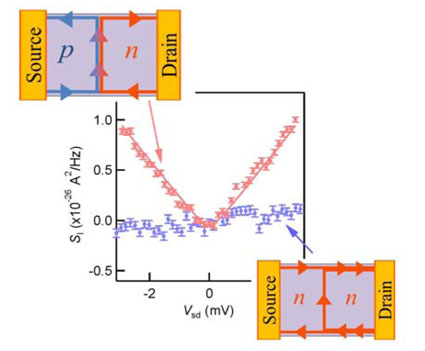Edge Mixing Dynamics in Graphene p–n Junctions in the Quantum Hall Regime
|
This research topics is based on the studies published in “Nature Communications“on September 4, 2015.
Prof. Ono, T., Assoc Prof. Kobayashi, K.,1 Assist Prof. Moriyama, T., Dr. Matsuo, S.2 (Nanospintronics, Division of Materials Chemistry)
Dr. Tsukagoshi, K. (MANA Principal Investigator in NIMS) |
Prof. Ono, T., Assoc Prof. Kobayashi, K. (presently Professor in Osaka University) (From Left)
Assist Prof. Moriyama, T., Dr. Matsuo, S. (presently Assistant Professor in the University of Tokyo) (From Left) |
||||
|
Massless Dirac electron systems such as graphene exhibit a distinct half-integer quantum Hall effect, and in the bipolar transport regime co-propagating edge states along the p–n junction are realized. Additionally, these edge states are uniformly mixed at the junction, which makes it a unique structure to partition electrons in these edge states. Although many experimental works have addressed this issue, the microscopic dynamics of electron partition in this peculiar structure remains unclear. Here we performed shot-noise measurements on the junction in the quantum Hall regime as well as at zero magnetic field. We found that, in sharp contrast with the zero-field case, the shot noise in the quantum Hall regime is finite in the bipolar regime, but is strongly suppressed in the unipolar regime. Our observation is consistent with the theoretical prediction and gives microscopic evidence that the edge states are uniquely mixed along the p–n junction. |
|||||
|
|
Figure 1. Results of shot noise measurements |
||||
|
This work was partially supported by the Collaborative Research Program of the Institute for Chemical Research, Kyoto University . |
|||||
 Institute for Chemical Research, Kyoto University
Institute for Chemical Research, Kyoto University International Joint Usage Research Center
International Joint Usage Research Center

